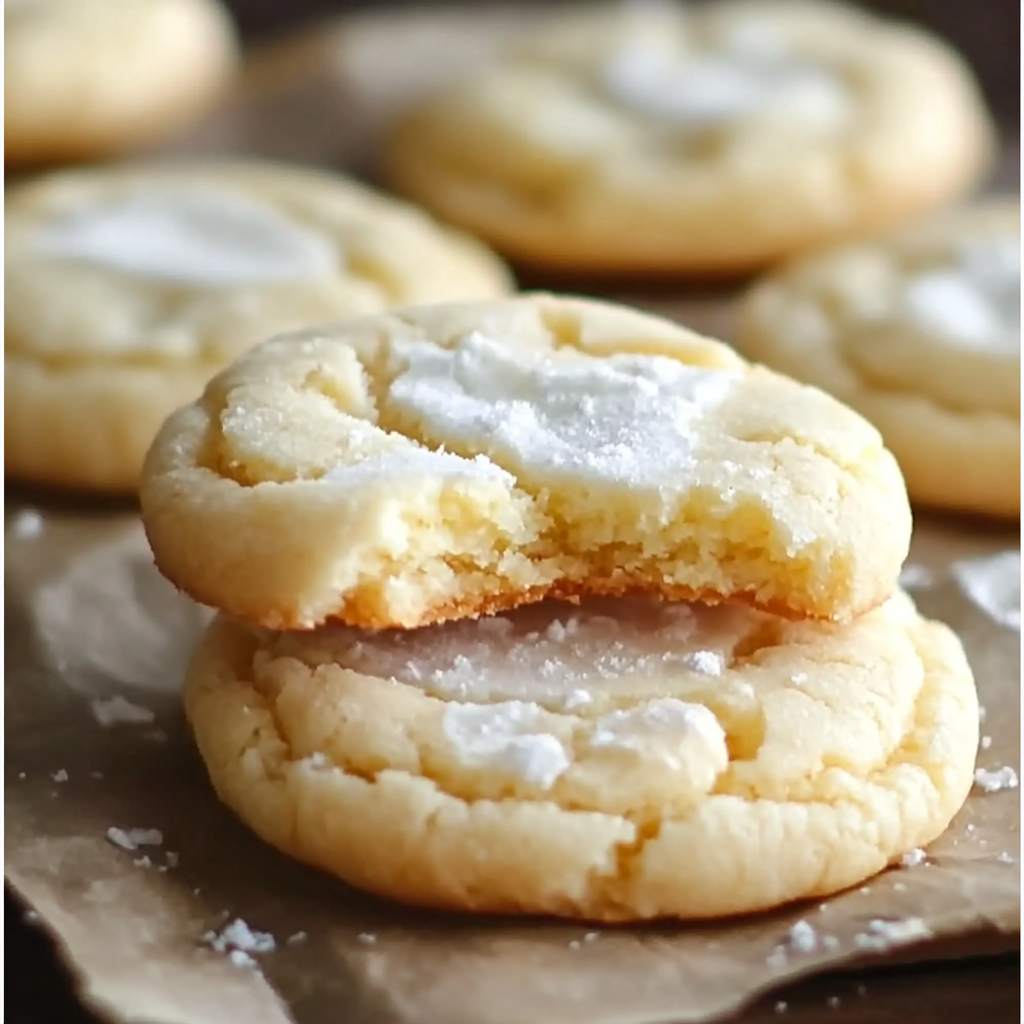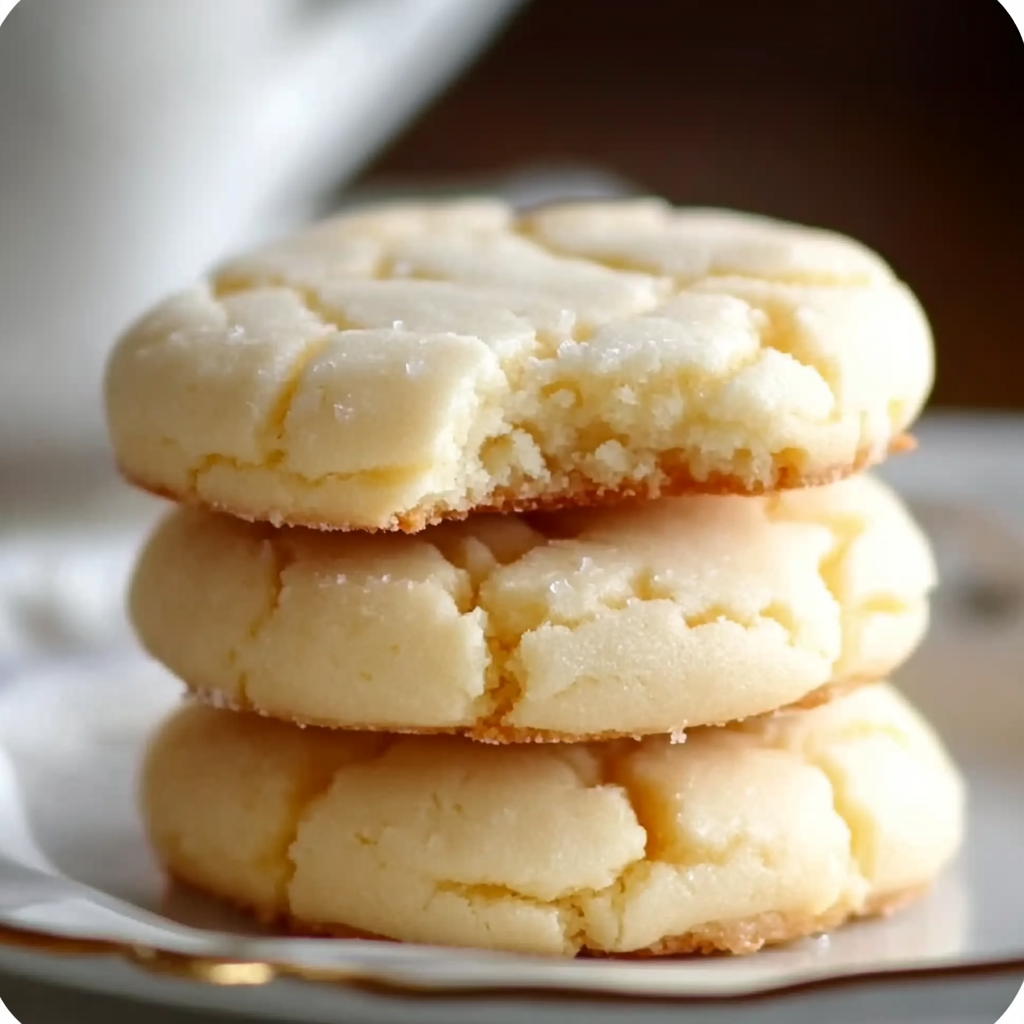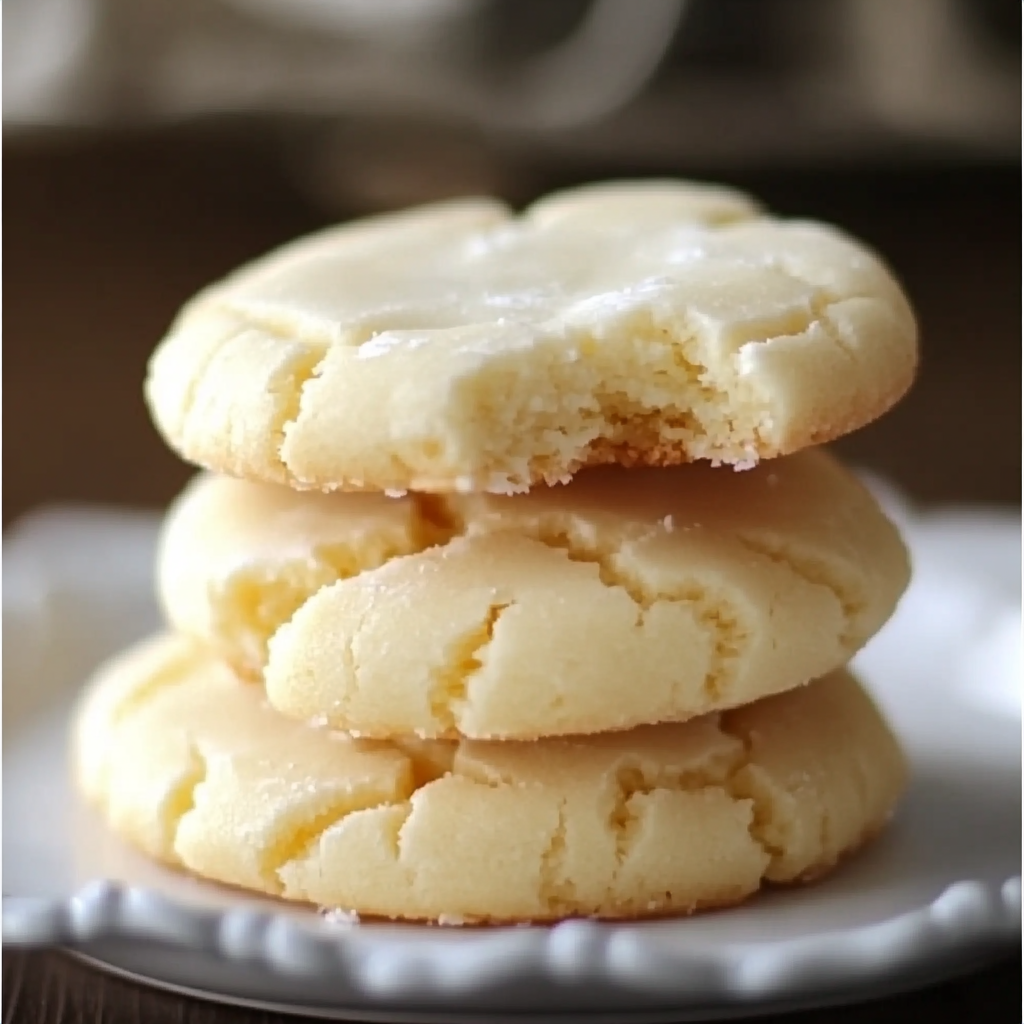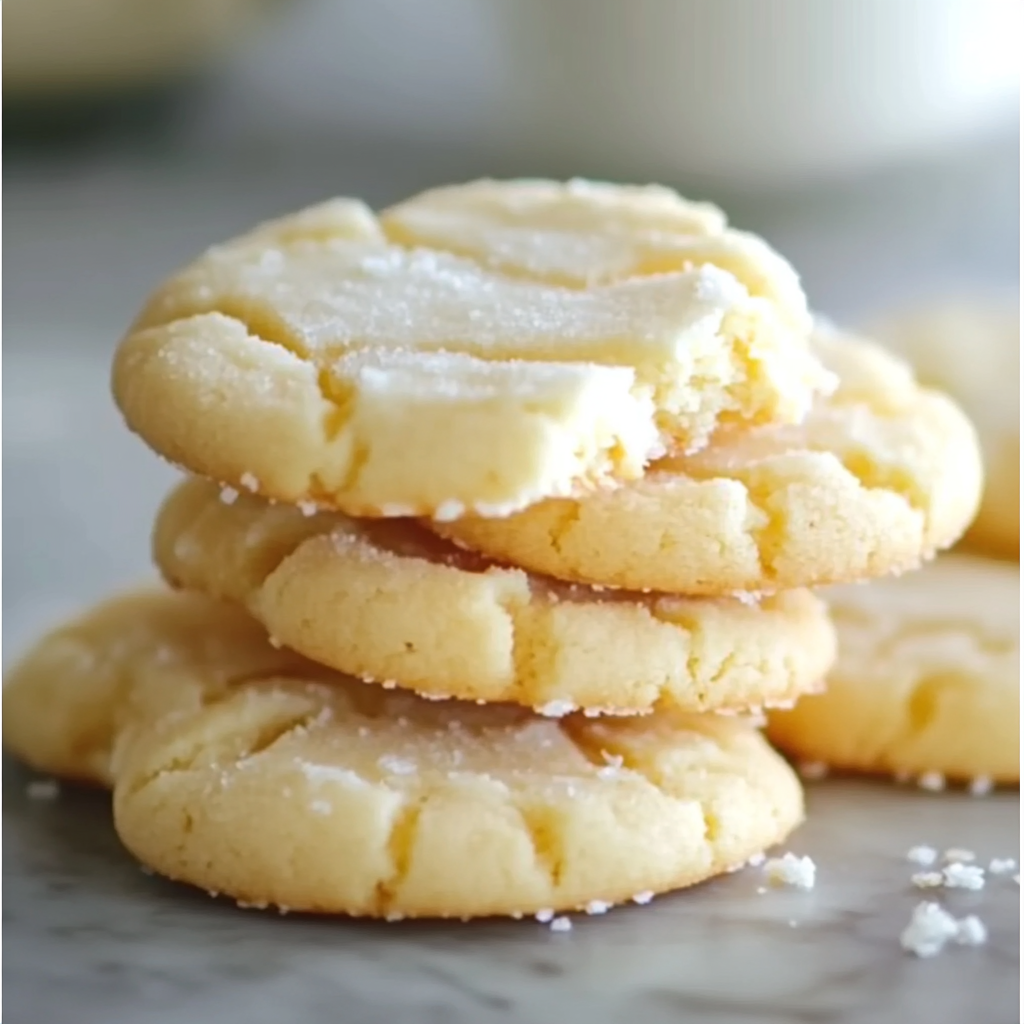Why You’ll Love These Lemon Meltaway Cookies
There’s something truly irresistible about lemon meltaway cookies. Light, buttery, and bursting with bright citrus flavor, they’re the kind of treat that disappears within minutes of serving. These cookies don’t just melt in your mouth—they dissolve with a delicate crumb and a sweet, tart glaze that keeps you reaching for another. If you’re a fan of simple, homemade desserts that look elegant but are deceptively easy to make, this recipe is for you.
What sets these cookies apart is the perfect balance of zesty lemon and smooth buttery texture. Thanks to a combination of cornstarch and powdered sugar, the dough yields a cookie that feels like a cross between shortbread and cloud-like confections. Whether you’re baking for a summer brunch, holiday gifts, or just to treat yourself, this is a recipe worth bookmarking.
If you love experimenting in the kitchen, try pairing this cookie recipe with others like traditional shortbread or citrus-based lemon desserts to create a full-flavored dessert platter. Incorporating lemon zest also adds more than just aroma—it infuses the dough with essential oils that elevate the flavor beyond what bottled juice can deliver. Not sure how to zest properly? Here’s a quick visual guide to lemon zesting to ensure you get the most out of your citrus.
Stay tuned, because up next, we’ll explore exactly what makes lemon meltaway cookies so unique—and how they differ from your average sugar cookie or biscuit.

2. What Are Lemon Meltaway Cookies?
Lemon meltaway cookies are tender, citrus-infused treats known for their buttery texture and delicate crumb. They quite literally “melt away” in your mouth, thanks to a unique dough that blends cornstarch, powdered sugar, and butter. The result is a cookie that’s light, slightly crisp at the edges, and velvety soft in the center.
Unlike classic sugar cookies or crunchy shortbread, meltaways prioritize a creamy texture and mild sweetness that allows the lemon to shine. These cookies aren’t chewy—they dissolve, giving you a bright burst of lemon with every bite. The flavor comes from fresh lemon juice and zest, delivering a natural tartness that balances the buttery base beautifully.
Where do meltaways fit in the cookie family? Think of them as a softer, more refined cousin to traditional shortbread, but less dense than a typical holiday cookie. Their subtle lemon glaze also sets them apart, giving them an elegant finish without overwhelming sweetness. Many bakers include meltaways as part of assorted cookie gift boxes—if you’re assembling one, consider adding decorative touches from Pinterest’s cookie gift ideas for inspiration.
These cookies are perfect for:
-
Afternoon tea or brunch spreads
-
Spring or summer dessert tables
-
Homemade gifts during the holidays
-
Anytime snacking when you’re craving something citrusy
Need more ideas? Check out these cookie decorating tips to make your lemon meltaways look as good as they taste.
Next, let’s break down the essential ingredients that make these cookies a must-try.
3. Key Ingredients Breakdown
Understanding the role of each ingredient is essential when baking the perfect lemon meltaway cookies. Each component works together to create a cookie that is light, soft, and full of zesty flavor. Here’s a breakdown of what you’ll need and why each ingredient matters:
-
Unsalted Butter
Butter is the foundation of this recipe. Using unsalted butter ensures that you can control the salt content, which is crucial in a delicate cookie like this. It also provides richness and helps achieve that melt-in-your-mouth texture. Be sure to use softened butter so it creams well with the sugar. -
Powdered Sugar
Unlike granulated sugar, powdered sugar dissolves easily into the dough, contributing to a smoother texture. It also adds just the right amount of sweetness without graininess. This ingredient plays a big part in creating the cookie’s signature delicate crumb. -
Fresh Lemon Juice and Zest
These are the stars of the flavor profile. Lemon zest contains fragrant oils that provide an intense lemon aroma, while the juice adds bright, tangy acidity. Avoid bottled juice if possible—it lacks the freshness and complexity of flavor. Not sure how to zest a lemon? Follow this helpful visual guide to master it. -
All-Purpose Flour
This gives structure to the cookies, balancing the fat from the butter. Be careful not to overmix the dough once the flour is added—doing so can result in tough cookies. -
Cornstarch
The secret ingredient. Cornstarch softens the flour’s gluten, helping produce that light, meltaway consistency. This is what sets meltaway cookies apart from other cookie varieties. -
Salt
A small amount of salt enhances the other flavors, especially the brightness of the lemon.
Need ideas for tweaking your ingredients? Pinterest’s baking tips offer creative substitutions and enhancements for cookies of all types.
Now that we’ve covered the ingredients, let’s move on to the tools and prep work needed before baking.
4. Tools and Prep: What You’ll Need
Before diving into the baking process, it’s important to gather the right tools and prep your workspace. Having everything ready ensures a smooth, enjoyable experience—and helps you avoid overmixing or skipping steps. Here’s what you’ll need to make lemon meltaway cookies with ease:
-
Mixing Bowls
Use one large bowl for the wet ingredients and another for the dry. This keeps the ingredients evenly incorporated and prevents clumping. -
Electric Mixer or Stand Mixer
Creaming butter and sugar is much easier with a mixer. It also helps you achieve the light, airy texture that defines meltaway cookies. If you’re mixing by hand, be prepared to spend extra time to reach the right consistency. -
Measuring Cups and Spoons
Precise measurements are crucial in baking. Use dry measuring cups for flour and cornstarch, and liquid measuring cups for lemon juice. Don’t eyeball it—especially with powdered sugar and lemon juice, which directly affect taste and texture. -
Microplane or Zester
This tool ensures you extract the flavorful oils from the lemon peel without the bitter white pith. If you’re new to zesting, take a look at how to zest a lemon properly for best results. -
Baking Sheet & Parchment Paper
Parchment paper prevents sticking and allows for even baking. It also makes cleanup easier and eliminates the need for greasing the pan. -
Wire Rack
Proper cooling is essential for setting the glaze and preserving texture. A wire cooling rack allows air to circulate evenly around the cookies.
Before you start, preheat your oven to 350°F (175°C) and line your baking sheet. This step saves time and ensures that once your dough is ready, you’re not waiting for the oven to heat.
With your tools in place, you’re ready to mix, shape, and bake these zesty lemon cookies. In the next section, we’ll walk through the entire process, from creaming the butter to finishing with the glaze.
5. Step-by-Step: How to Make Lemon Meltaway Cookies
Making lemon meltaway cookies is a straightforward process, but attention to detail at each step ensures they come out perfectly soft, delicate, and bursting with citrus flavor. Follow this step-by-step guide for bakery-level results.
5.1. Mixing the Wet Ingredients
-
In a large mixing bowl, cream together 1 cup unsalted butter and ½ cup powdered sugar using a hand or stand mixer on medium speed. Beat until the mixture becomes fluffy and pale.
-
Add 1 tablespoon of lemon zest and 2 tablespoons of fresh lemon juice. Mix until everything is fully combined.
This stage infuses the dough with flavor—lemon zest is key. For the best results, avoid bottled juice, and learn how to properly zest using this lemon zesting guide.
5.2. Combining the Dry Ingredients
-
In a separate bowl, whisk together:
-
1¾ cups all-purpose flour
-
¼ cup cornstarch
-
¼ teaspoon salt
-
-
Slowly add the dry ingredients to the wet mixture in batches. Mix on low speed until a soft dough forms. Do not overmix, as this will compromise the meltaway texture.
Cornstarch is critical here. It reduces the protein strength in the flour, resulting in cookies that are less chewy and more tender and crumbly. This is what differentiates them from traditional cookies or even basic sugar cookies.
5.3. Shaping the Cookies
-
Scoop out small portions of dough and roll into 1-inch balls.
-
Place each ball about 2 inches apart on a parchment-lined baking sheet.
-
Gently flatten each cookie with your palm or the bottom of a glass. This step ensures they bake evenly and don’t puff up.
If you’re preparing cookies for gifting, explore these creative cookie decorating ideas to elevate the presentation.
5.4. Baking to Perfection
-
Bake in a preheated oven at 350°F (175°C) for 12–14 minutes, or until the edges are set but not browned. The cookies should remain pale on top.
-
Let them rest on the baking sheet for 2–3 minutes, then transfer to a wire cooling rack.
Timing is essential—overbaking will ruin the soft, melt-in-your-mouth effect. If you’re new to baking, check out these cookie baking tips for guidance.

6. Making the Zesty Lemon Glaze
Once the cookies are completely cooled, it’s time to add a tangy finishing touch that enhances both flavor and appearance.
-
In a small bowl, whisk together:
-
1 cup powdered sugar
-
1–2 tablespoons fresh lemon juice
-
-
Optional: Add 1 teaspoon lemon zest for extra zing and visual appeal.
Adjust the lemon juice to achieve a smooth, pourable consistency. You want the glaze to coat but not soak the cookies. Drizzle using a spoon or piping bag for precision.
Let the glaze set at room temperature before storing or serving. Once set, the glaze adds a subtle crackle and shine, perfect for gift boxes or party platters. For inspiration on presentation, browse cookie gift box ideas.
Up next: Expert baking tips to help you perfect this recipe every time.
7. Pro Tips for the Best Lemon Meltaway Cookies
Perfecting lemon meltaway cookies is about mastering small techniques that elevate your final result. Here are essential tips to keep your cookies light, flavorful, and professional-looking:
-
Use Room Temperature Ingredients
Cold butter won’t cream properly, and uneven temperature can lead to dense cookies. Let all ingredients sit out for 30 minutes before you begin. -
Don’t Overbake
These cookies should not brown on top. Pull them from the oven when they’re just set—the residual heat will finish them. This preserves the soft, tender texture. -
Chill the Dough (Optional)
If your kitchen is warm or the dough seems too sticky, refrigerate it for 15–20 minutes. This helps prevent spreading during baking. -
Zest First, Then Juice
Always zest your lemon before juicing to avoid slippery fruit and lost flavor. Learn the right technique from Pinterest’s guide to zesting. -
Use Fresh Lemon Juice Only
Bottled lemon juice lacks the bright citrus oils found in fresh lemons. Squeeze it fresh for optimal flavor.
Following these pro tips ensures that your lemon cookies taste as good as they look.
8. Variations and Flavor Twists
While the classic lemon meltaway cookie is a standout on its own, here are a few ways to add variety and keep things interesting:
-
Add Herbs
Mix in a teaspoon of finely chopped rosemary or lavender for a subtle, floral note. This pairs beautifully with the lemon base. -
White Chocolate Drizzle
For extra decadence, melt white chocolate and drizzle over the cooled cookies instead of the lemon glaze. Or do both for a layered effect. -
Lemon-Poppy Seed Version
Stir in 1 tablespoon of poppy seeds to the dough for a mild crunch and an added visual touch—an easy twist on a classic. -
Citrus Swap
Try using orange or lime zest and juice for a different citrus experience. Lemon-based desserts offer endless inspiration for flavor combinations. -
Gluten-Free Option
Use a 1:1 gluten-free flour blend to make these cookies gluten-free. Add ¼ teaspoon of xanthan gum if the mix doesn’t already include it.
Get creative and make this recipe your own!
9. How to Store and Freeze Lemon Meltaway Cookies
Preserving the freshness and texture of lemon meltaway cookies is simple if you follow these storage tips:
-
Room Temperature Storage
Store cooled and glazed cookies in an airtight container at room temperature for up to 5 days. Place wax or parchment paper between layers to prevent sticking. -
Refrigeration
Cookies can be refrigerated for longer freshness, but allow them to come to room temperature before serving for best flavor. -
Freezing
-
Unbaked Dough: Scoop dough into balls and freeze on a baking sheet. Once firm, transfer to a freezer-safe bag. Bake from frozen, adding 1–2 minutes to the bake time.
-
Baked Cookies: Freeze plain cookies before glazing. When ready to serve, thaw and glaze fresh.
-
Cookies make great gifts—check out gift packaging ideas to keep them looking beautiful and intact.
10. Serving Suggestions
Serve lemon meltaway cookies in ways that complement their elegant flavor and appearance:
-
Afternoon Tea
Pair with black tea, chamomile, or a light green tea for a refined snack. -
Holiday Dessert Platters
Combine with other shortbread or sugar cookies for a colorful, flavorful array. -
Lemon-Themed Party
Include them in a lemon-focused dessert table with cupcakes, curd tarts, and lemonade. -
Gift Boxes or Jars
Package with a ribbon and tag. These cookies are sturdy and store well—perfect for sharing. -
Cookie Exchange or Bake Sale
Their unique flavor and texture help them stand out. Use these cookie decorating ideas for added flair.
Now let’s answer the most common questions bakers have about this delightful treat.

11. FAQs – People Also Ask
Q1: Why are my lemon cookies spreading too much?
This usually happens when the butter is too soft or the dough is too warm. Try chilling the dough for 15–30 minutes before baking. Be sure to measure ingredients accurately using proper baking tools.
Q2: Can I make these cookies gluten-free?
Yes, use a gluten-free all-purpose flour blend and add a stabilizer like xanthan gum if your mix doesn’t include it. The result should still be light and tender.
Q3: Can I use bottled lemon juice instead of fresh?
Fresh is always better. Bottled lemon juice lacks the natural oils and aroma found in fresh lemons. For optimal flavor, always zest and juice your lemons just before baking.
Q4: Do lemon meltaway cookies need to be refrigerated?
Not necessarily. Store in an airtight container at room temperature. If your environment is warm or humid, refrigeration can help maintain freshness.
Q5: Can I make the dough ahead of time?
Absolutely. The dough can be made up to 48 hours in advance and stored in the fridge. You can also freeze unbaked dough balls for longer storage and bake straight from frozen.
How to Make the Best Lemon Meltaway Cookies Ever
These Lemon Meltaway Cookies are soft, buttery, and infused with bright lemon flavor. They’re quick to make and feature a tangy glaze that enhances their light texture. Perfect for tea time, holiday gifting, or citrus lovers, this recipe guarantees a cookie that truly melts in your mouth.
- Author: Clara
Ingredients
For the cookies:
- 1 cup (2 sticks) unsalted butter, softened
- ½ cup powdered sugar
- 1 tbsp lemon zest
- 2 tbsp fresh lemon juice
- 1 ¾ cups all-purpose flour
- ¼ cup cornstarch
- ¼ tsp salt
For the glaze:
- 1 cup powdered sugar
- 1–2 tbsp fresh lemon juice
- 1 tsp lemon zest (optional for extra zing)
Instructions
Preheat your oven to 350°F (175°C). Line a baking sheet with parchment paper.
In a large bowl, cream together the softened butter and powdered sugar until light and fluffy.
Mix in the lemon zest and lemon juice until fully combined.
In a separate bowl, whisk together the flour, cornstarch, and salt.
Gradually add the dry ingredients to the wet mixture, stirring until a soft dough forms.
Scoop out small portions of dough and roll into 1-inch balls. Place them on the prepared baking sheet about 2 inches apart.
Flatten each ball gently with the bottom of a glass or your palm.
Bake for 12–14 minutes, or until the edges are set but not browned. Let cool completely on a wire rack.
To make the glaze, whisk together powdered sugar and lemon juice until smooth. Drizzle over the cooled cookies. Sprinkle with additional lemon zest if desired.
Let the glaze set before storing or serving.
Notes
-
Always use fresh lemon juice and zest for optimal flavor.
-
Chill the dough if cookies spread too much.
-
Do not overbake; they should remain pale and soft.
-
Glaze only after the cookies are fully cooled.
-
Store in an airtight container for up to 5 days at room temperature.




